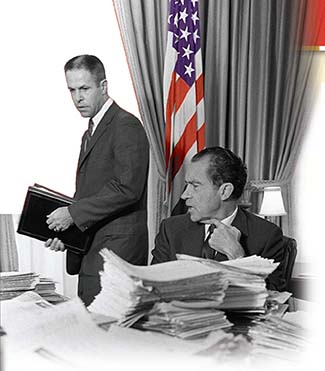SECTION 1: Nixon and the Watergate Scandal

▲ Nixon and aide H. R. Haldeman
WITNESS HISTORY  AUDIO
AUDIO
The Watergate Tapes
Not long after President Nixon’s 1972 reelection, the huge Watergate scandal began to unfold. The root of the scandal was a break-in at the Democratic Party’s headquarters in Washington, D.C. Tapes of White House conversations later revealed that Richard Nixon and his top aides had tried to cover up the break-in:
“H. R. Haldeman [assistant to the President]: Now, on the investigation, you know, the Democratic break-in thing, we’re back to the—in the problem area because the FBI is not under control, because [FBI Director L. Patrick] Gray doesn’t exactly know how to control them [his agents]…. [The] way to handle this now is for us to have [Deputy CIA Director] Walters call Pat Gray and just say, ‘Stay … out of this.’ … President Nixon: You call them in…. Play it tough. That’s the way they play it and that’s the way we are going to play it.”
—Taped conversation, Oval Office, White House, June 23, 1972
Objectives
- Describe Richard Nixon’s attitude toward “big” government.
- Analyze Nixon’s southern strategy.
- Explain the Watergate incident and its consequences.
Terms and People
- silent majority
- stagflation
- OPEC
- southern strategy
- affirmative action
- Watergate
- Twenty-fifth Amendment
- executive privilege
NoteTaking
Reading Skill: Identify Main Ideas Record Nixon’s major domestic policies and goals in a chart like the one below.
| New Federalism | Southern Strategy |
|---|---|
Why It Matters President Richard Nixon stood at the summit of his long government career when he was reelected President in a landslide in November 1972. Yet, less than two years later, Nixon left office in disgrace, the first time a President of the United States had resigned. The Watergate scandal gripped the nation and shaped the values and attitudes toward government that many Americans hold today. Section Focus Question: What events led to Richard Nixon’s resignation as President in 1974?
Nixon’s Policies Target Middle America
Richard Nixon’s political career had more ups and downs than a roller coaster ride. Brought up in hard times, he worked his way through college and law school. After service in the navy during World War II, Nixon was elected to the House of Representatives in 1946 and then to the Senate in 1950. As Dwight Eisenhower’s running mate in 1952, he became Vice President with Eisenhower’s victory. Nixon was not yet 40 years old.
Then came the defeats. In 1960, Nixon narrowly lost to John F. Kennedy in the race for the White House. Two years later, Nixon’s career hit bottom when he lost an election to become governor of California. In 1968, however, Nixon made a dramatic comeback, narrowly defeating Democrat Hubert Humphrey to win the presidency.




